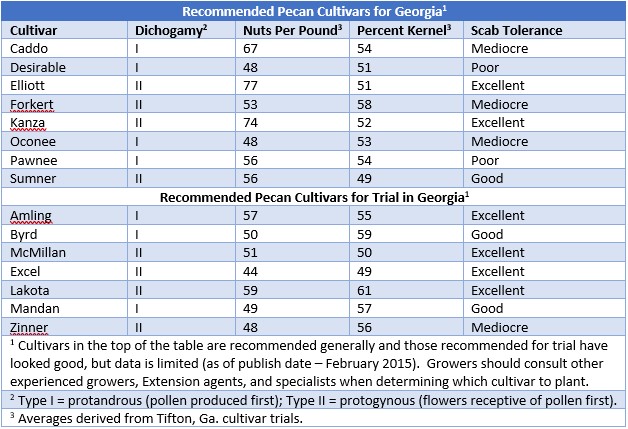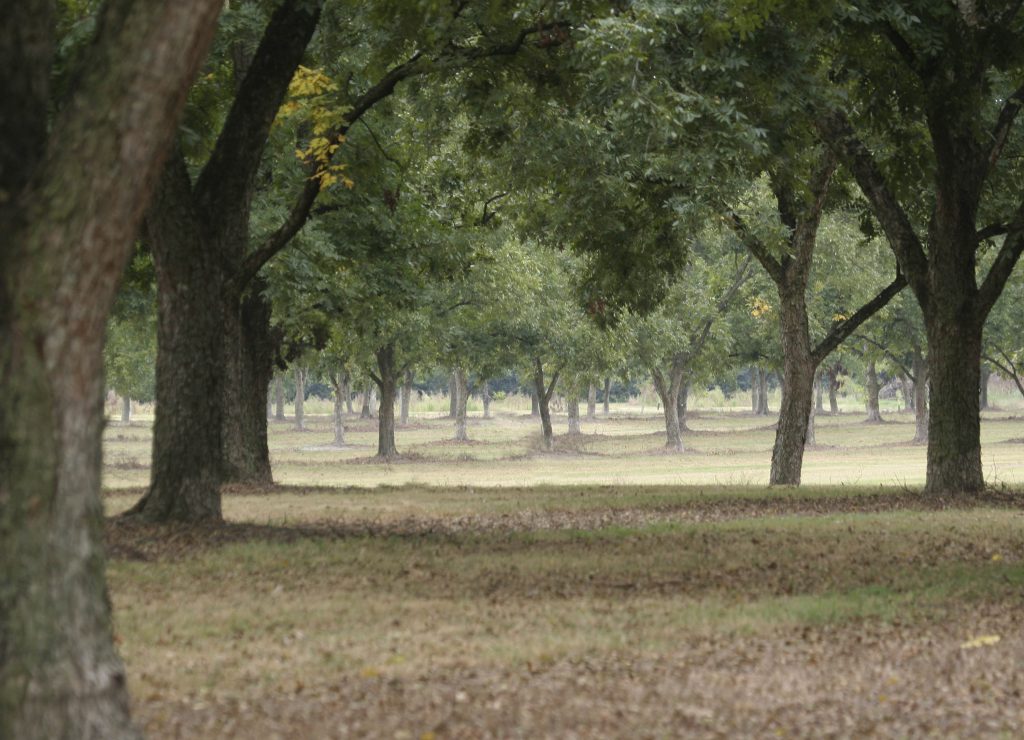Whether you are starting an orchard or planting a few pecan trees to diversify your small farm, there are a number of things you should consider first such as recommended cultivars (cultivated varieties), tree spacing, and nutrition. Although there are a lot of things to consider when deciding on an agricultural enterprise, these three topics are the focus of the most frequently asked questions (FAQ) by farmers interested in establishing commercial pecan production.
–
Variety Selection
Scab tolerance is one of the most important things to consider when selecting varieties. Other things to consider are tree availability, dichogamy (cross-pollination), and tree structure. The University of Georgia is one of the top breeders of pecan trees in the United States. Most of their varieties are selected for scab tolerance. Trees should also be selected based on dichogamy. Dichogamy occurs in plants that have both male and female flowers/flower parts. Some pecan trees produce pollen before the female flowers become receptive of pollen, while other trees have female flowers that become receptive of pollen before their male flowers produce pollen. These traits help prevent trees from self-pollination. Trees are classified as either Type I/protandrous (pollen is produced before female flowers become receptive) or Type II/protogynous (female flowers become receptive before pollen is produced).

Table data derived from the publication “Pecan Varieties for Georgia Orchards”.
–
Tree Spacing
Tree spacing recommendations are fairly standard, but some people prefer to stretch the limits to increase yields in young orchards. High density orchards consist of more than 35 trees per acre. These orchards require a larger investment in labor and capital than conventional orchards. A spacing of at least 30 ft. by 60 ft. is recommended to allow for good airflow, reduced shading, and equipment access. Of course, not all land is flat, so not all orchards can be laid out on a perfect grid. If the land is sloping, the tree planting should follow the contours of the land and terraces may need to be constructed to reduce erosion. Tree thinning is recommended when trees reach a size that causes 50 percent of the orchard floor to be shaded at mid-day.
–
Nutrition
Pecan trees should not be fertilized at planting. Newly planted trees should be fertilized with 1 pound of 10-10-10 in May/June (distributed in a 25 sq. ft. circumference around the tree). In the second year after planting, trees should receive 1 pound of 10-10-10 in March, May, and June. In subsequent years, 4 pounds of 10-10-10 should be applied per inch of trunk diameter measured 1 foot from the soil surface. Applications should be split between March and June. In addition to 10-10-10, zinc sulfate should be applied, if soil tests indicate deficiencies. These recommendations are general. To better evaluate pecan tree nutritional needs, leaf/foliar tissue analysis should be conducted annually. Leaves should be sampled between July 7 and August 7 for best results. Leaf samples can be submitted to the UF/IFAS Analytical Services Laboratories Extension Soil Testing Laboratory along with the Plant Tissue Test Form. It’s important that a paper/cloth bag is used for the sample rather than plastic.
–
More Resources
These are just a few tips to address the most commonly asked questions for growing pecan trees in North Florida. For more detailed information, please see the information available at the following links.
–
Pecan Varieties for Georgia Orchards
Pecan Cultivars for North Florida
Pecan Trees for the Home or Backyard Orchard
Establishing a Pecan Orchard
Cultural Management of Commercial Pecan Orchards
- Crops to Consider for Fall Planting - September 26, 2025
- Benefits of Manure Fertilizers and Analysis - March 21, 2025
- Mushrooms – A Crop Worth Consideration for the Back Forty - October 4, 2024


